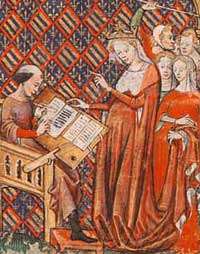Joan the Lame
| Joan the Lame | |
|---|---|
 | |
| Queen consort of France | |
| Tenure | 1 April 1328 – 12 September 1348 |
| Coronation | 27 May 1328 |
| Born | 24 June 1293 |
| Died | 12 December 1349 (aged 56) |
| Burial | Basilica of St Denis, France |
| Spouse | Philip VI of France |
| Issue |
John II of France Philip, Duke of Orléans |
| House | Burgundy |
| Father | Robert II, Duke of Burgundy |
| Mother | Agnes of France |
| Religion | Roman Catholicism |
Joan of Burgundy (French: Jeanne; 24 June 1293 – 12 December 1349), also known as Joan the Lame (French: Jeanne la Boiteuse), was Queen of France as the first wife of King Philip VI. Joan served as regent while her husband fought on military campaigns during the Hundred Years' War.
Background
Joan was the daughter of Robert II, Duke of Burgundy, and Agnes of France.[1] Her older sister, Margaret, was the first wife of Louis X of France.[2] Joan married Philip of Valois, Louis's cousin, in July 1313. From 1315 to 1328, they were Count and Countess of Maine;[2] from 1325, they were also Count and Countess of Valois and Anjou.
Queenship
King Philip IV's sons: Louis X, Philip V, and Charles IV, left no surviving male heirs, leading to the accession of Joan's husband to the French throne. The Hundred Years' War ensued, with Edward III of England, a nephew of Louis X, claiming the French crown. Intelligent and strong-willed, Joan proved a capable regent while her husband fought on military campaigns during the war. However, her nature and power earned both herself and her husband a bad reputation, which was accentuated by her deformity (which was considered by some to be a mark of evil), and she became known as la male royne boiteuse ("the lame evil Queen"). One chronicler described her as a danger to her enemies in court: "the lame Queen Jeanne de Bourgogne...was like a King and caused the destruction of those who opposed her will."[3]
She was also considered to be a scholarly woman and a bibliophile: she sent her son, John, manuscripts to read, and commanded the translation of several important contemporary works into vernacular French, including the Miroir historial of Vincent de Beauvais (c.1333) and the Jeu d'échecs moralisés of Jacques de Cessoles (c.1347), a task carried out by Jean de Vignay.
Joan died of the plague by 1349.[4] She was buried in the Basilica of Saint Denis; her tomb, built by her grandson Charles V, was destroyed during the French Revolution.
Family, children and descent
Her children with Philip VI were:
- John II (26 April 1319 – 8 April 1364).
- Marie (1326 – 22 September 1333), who married John of Brabant, the son and heir of John III, Duke of Brabant, but died shortly afterwards.
- Louis (born and died 17 January 1329).
- Louis (8 June 1330 – 23 June 1330).
- A son [John?] (born and died 2 October 1333).
- A son (28 May 1335), stillborn.
- Philip (1 July 1336 – 1 September 1375), Duke of Orléans
- Joan (born and died November 1337).
- A son (born and died summer 1343).
In 1361, Joan's grandnephew, Philip I of Burgundy, died without legitimate issue, ending the male line of the Dukes of Burgundy. The rightful heir to Burgundy was unclear: King Charles II of Navarre, grandson of Joan's elder sister Margaret, was the heir according to primogeniture, but John II of France (Joan's son) claimed to be the heir according to proximity of blood. In the end, John won.
Ancestry
| Ancestors of Joan the Lame | ||||||||||||||||||||||||||||||||||||||||||||||||||||||||||||||||||||||||||||||||||||||||||||||||||||||||||||||||||||||||||||||||||||||||||||||||||||||||||||||||||||||||||||||||||||||||||||||||||||||||||||||||||||||||||||||||||||||||||||||||||||||||||||||||||||||||||||||||||||||||||||||||||||||||||||||||||||||||||||||||||||||||||||||||||||||||||||||||||||||||||||||||||||||||||||||||||||||||||||||||||||||||||||||||||||||||||||||||||||||||||||||||||||||||||||||||||||||||||||||||||||||||||||||||||||||||||||||||||
|---|---|---|---|---|---|---|---|---|---|---|---|---|---|---|---|---|---|---|---|---|---|---|---|---|---|---|---|---|---|---|---|---|---|---|---|---|---|---|---|---|---|---|---|---|---|---|---|---|---|---|---|---|---|---|---|---|---|---|---|---|---|---|---|---|---|---|---|---|---|---|---|---|---|---|---|---|---|---|---|---|---|---|---|---|---|---|---|---|---|---|---|---|---|---|---|---|---|---|---|---|---|---|---|---|---|---|---|---|---|---|---|---|---|---|---|---|---|---|---|---|---|---|---|---|---|---|---|---|---|---|---|---|---|---|---|---|---|---|---|---|---|---|---|---|---|---|---|---|---|---|---|---|---|---|---|---|---|---|---|---|---|---|---|---|---|---|---|---|---|---|---|---|---|---|---|---|---|---|---|---|---|---|---|---|---|---|---|---|---|---|---|---|---|---|---|---|---|---|---|---|---|---|---|---|---|---|---|---|---|---|---|---|---|---|---|---|---|---|---|---|---|---|---|---|---|---|---|---|---|---|---|---|---|---|---|---|---|---|---|---|---|---|---|---|---|---|---|---|---|---|---|---|---|---|---|---|---|---|---|---|---|---|---|---|---|---|---|---|---|---|---|---|---|---|---|---|---|---|---|---|---|---|---|---|---|---|---|---|---|---|---|---|---|---|---|---|---|---|---|---|---|---|---|---|---|---|---|---|---|---|---|---|---|---|---|---|---|---|---|---|---|---|---|---|---|---|---|---|---|---|---|---|---|---|---|---|---|---|---|---|---|---|---|---|---|---|---|---|---|---|---|---|---|---|---|---|---|---|---|---|---|---|---|---|---|---|---|---|---|---|---|---|---|---|---|---|---|---|---|---|---|---|---|---|---|---|---|---|---|---|---|---|---|---|---|---|---|---|---|---|---|---|---|---|---|---|---|---|---|---|---|---|---|---|---|---|---|---|---|---|---|---|---|---|---|---|---|---|---|---|---|---|---|---|---|---|---|---|---|---|---|---|---|---|---|---|---|---|---|---|---|---|---|---|---|---|---|---|---|---|---|---|---|---|---|---|---|---|---|---|---|---|---|---|---|---|---|---|---|---|---|---|---|---|---|---|---|---|---|---|---|---|---|---|---|---|---|---|---|---|---|---|---|---|---|---|---|---|---|---|---|---|---|---|
| ||||||||||||||||||||||||||||||||||||||||||||||||||||||||||||||||||||||||||||||||||||||||||||||||||||||||||||||||||||||||||||||||||||||||||||||||||||||||||||||||||||||||||||||||||||||||||||||||||||||||||||||||||||||||||||||||||||||||||||||||||||||||||||||||||||||||||||||||||||||||||||||||||||||||||||||||||||||||||||||||||||||||||||||||||||||||||||||||||||||||||||||||||||||||||||||||||||||||||||||||||||||||||||||||||||||||||||||||||||||||||||||||||||||||||||||||||||||||||||||||||||||||||||||||||||||||||||||||||
In fiction
Joan is a character in Les Rois maudits (The Accursed Kings), a series of French historical novels by Maurice Druon. She was portrayed by Ghislaine Porret in the 1972 French miniseries adaptation of the series.
References
- ↑ A History of the Crusades: The fourteenth and fifteenth centuries, Vol. III, ed. Kenneth Meyer Setton, (University of Wisconsin Press, 1975), 773.
- 1 2 Elizabeth Hallam, Capetian France: 987-1328, (Longman, 1980), 282.
- ↑ Robert Knecht, The Valois: Kings of France 1328-1589, (Hambledon Continuum, 2004), 11.
- ↑ Jonathan Sumption, The Hundred Years War II:Trial by Fire, (University of Pennsylvania Press, 1999), 49.
| Joan the Lame Cadet branch of the Capetian dynasty Born: 24 June 1293 Died: 12 September 1348 | ||
| French royalty | ||
|---|---|---|
| Preceded by Jeanne d'Évreux |
Queen consort of France 1328–1348 |
Succeeded by Blanche of Navarre |